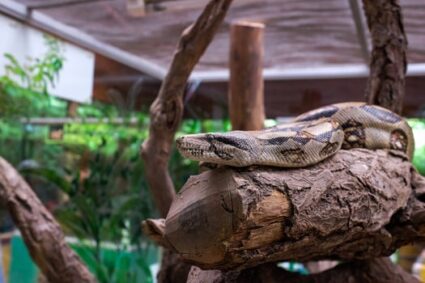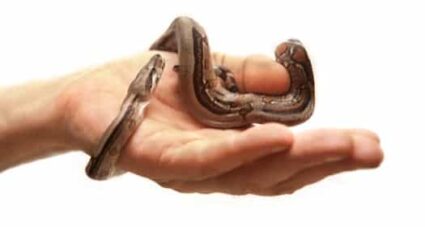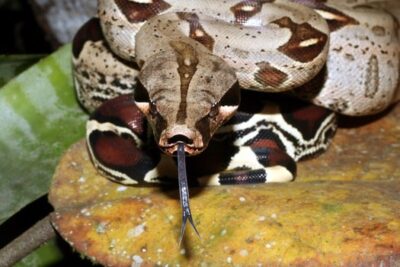Snakes produce their young in 3 different ways. While 70% of snakes lay eggs, other species retain the eggs inside their bodies. They then either give birth to live young or produce no eggs at all.
Boa constrictors are viviparous, so they don’t lay eggs. On average, one female boa may give birth to 30 to 60 live babies at a time.
Boas nourish their young via a placenta and yolk sac, where they’re enveloped in clear tenuous membranes. The babies develop inside their mother for a few months before birth and the clear membrane ruptures, allowing the female boa to give birth to live baby boas.
How Do Boa Constrictors Give Birth?
When a snake is viviparous, there is no egg involved in its reproductive process. So, neonate boa constrictors are already alive and active when they come into the world. There’s no egg or hatching process.
The embryo develops inside the mother and is nourished through a placenta. Because the boa offspring enter the world fully formed, they are quick to grow and soon become self-sufficient in the wild.
Internal Development of Baby Boas
Fertilization takes place internally in boas. The developing boa is connected to a yolk sac and is cocooned in a clear, tenuous sac. The embryos continue in this state for a few months, growing steadily inside the mother boa.
When the offspring are ready to be birthed, the protective membranes quickly break, facilitating the babies’ exit from the body.

However, this process is uncommon among snakes, as most species are either oviparous, while some are ovoviviparous.
As the babies are born, the mother boa continues to retain the eggs inside her, causing the hatchlings to come out of the mother alive.
Reproduction Methods in Snakes
| Reproduction Method | Facts and Information |
|---|---|
| Oviparous: | About 70% of snakes reproduce by laying eggs. The eggs have to be kept warm or incubated until the boa offspring are ready to come out of their shells. |
| Viviparous: | Snakes produce offspring without laying any eggs. The offspring develop inside the female and are nourished through a placenta. |
| Ovoviviparous: | Ovoviviparous snakes produce eggs that hatch inside their bodies. This is a cross between egg-laying snakes and snakes that give birth to live young. |
When Do Boa Constrictors Breed?
The boa constrictor breeding season usually starts between April and August, according to the University of Michigan. This is when the weather is dry and ideal for boa breeding.
Boa constrictors are polygynous. This means that both female and male boa constrictors often have multiple mates within one reproductive season.
During their breeding season, a female boa will emit pheromones from her cloaca, which helps to attract males. The male boas wrestle in order to select one suitable mate that can breed with her.
Following breeding, ovulation may not occur rapidly. However, the female boa can hold the sperm inside her body for up to one year.
During ovulation, you may notice a swelling in the female boa’s mid-body. Two to three weeks after ovulation, the female starts shedding. This is called a post-ovulation shed, which can last for up to 2 to 3 weeks.
Gestation Period in Boas
The gestation period of a boa mother lasts for about 100 to 150 days. Once the offspring are physically formed and birth is impending, it leaves the mother boa’s body through her cloacal cavity.
Baby boa constrictors instinctually gain the ability to stay alive from the day of their birth. Their young are independent right from the start and can begin feeding. This allows them to grow rapidly in the first few years, shedding continuously every 1 to 2 months.
After the birth of their offspring, it’s critical that mother boa constrictors have time to rest and heal. The internal embryonic development of baby boas involves high energy expenditure and takes its toll on her body.
How Many Babies Do Boa Constrictors Have?
There are approximately 25 baby boa snakes in one litter. However, they have been known to range anywhere from 10 to 60 snakes.
Some of the young may be stillborn, or unfertilized eggs, called “Slugs.”
Why Do Boa Constrictors Not Lay Eggs?
Most scientists agree that some species of snakes have a survival advantage of giving birth to live offspring rather than laying eggs.
Egg-laying species of snakes, except for the King Cobra, do not build their nests. They place their eggs in alligator nests, piles of rotting vegetation, or any other suitable spot that’s warm and has the ideal humidity levels that will incubate the eggs and prevent them from drying out.

Most snake eggs can take 50 to 60 days to hatch, so a proper location with the right temperature and moisture levels is imperative.
However, snakes that reside in cooler climates may face problems finding ideal nesting grounds for their eggs. This gives viviparous and oviparous an evolutionary advantage.
Since these snakes can continue developing their young inside their bodies, they can do what a mother snake with a clutch of eggs cannot. Female boa constrictors can move to a warmer location.
Snakes that can seek out optimal incubation conditions have a selective advantage over snakes that have to drop or abandon their eggs.
This shows that egg-laying snakes may not thrive in cooler parts of the world hence the reason why they’re more densely found in warmer, tropical conditions.
Does this mean that all live-bearing snakes reside in cooler climates? No, you can find snakes (including boa constrictors) that give birth to live young in every climate. However, egg-laying species have a slimmer survival advantage the further north you go.
Related Boa Reproduction Questions
How often do boa constrictors reproduce? Boa constrictors produce live offspring only once a year. However, only about half of the boa population is reproductive each year. Boas have 25 offspring in one litter, but this number can go up to 60 in some cases. On average, female boa constrictors have three to five litters during their entire lifespan.
Can boas reproduce without mating? In boas, reproduction is almost always sexual. However, one boa was found to reproduce asexually via a process called parthenogenesis. According to Science Direct, this is the growth and development of an embryo that occurs without fertilization.

